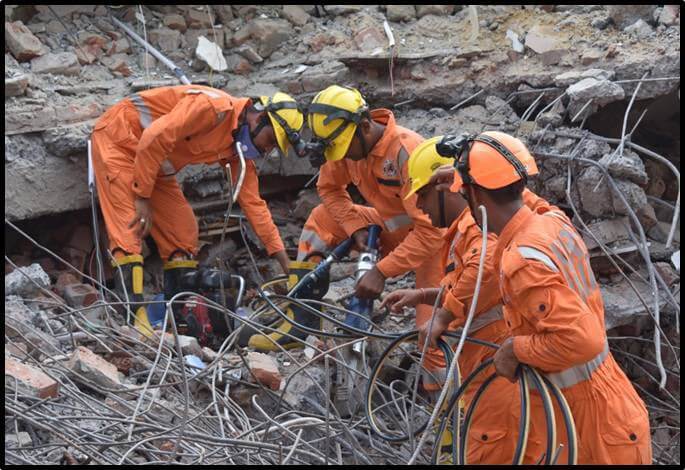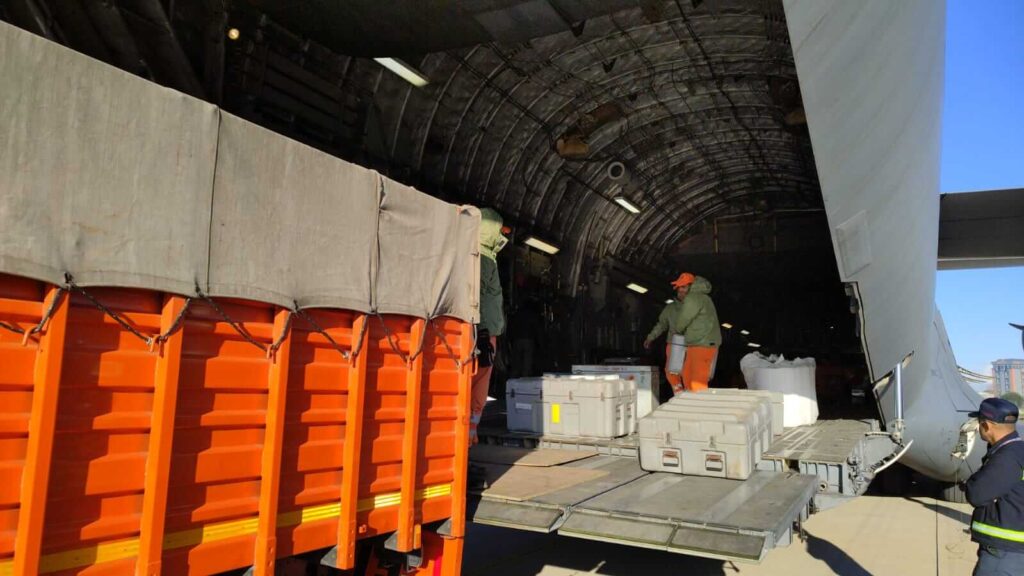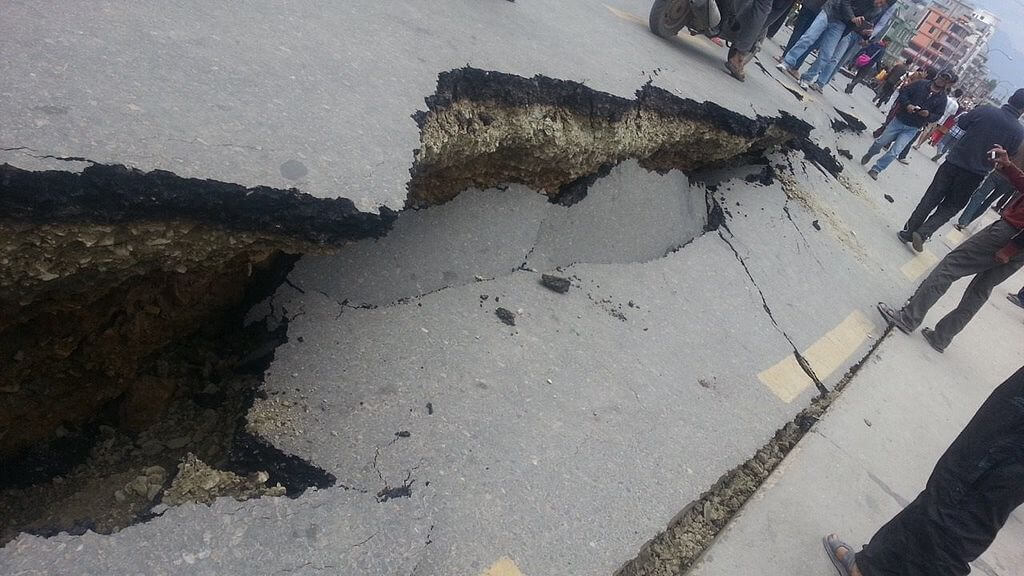NDRF – top disaster response force in the world

India is at the forefront of disaster management in the world.
The National Disaster Response Force (NDRF) is a specialized force equipped and trained to respond to disasters as well as spell out plans, procedures, and guidelines for disaster management under the Disaster Management Act, 2005. The NDRF headquartered in Delhi comes under the administrative purview of the National Disaster Management Authority (NDMA) headed by the Prime Minister of India.

It is headed by Atul Karwal a 1988 batch Gujarat cadre IPS officer who was Director, Sardar Vallabhbhai Patel National Police Academy before taking over as DG, NDRF on November 15, 2021. Adjudged ‘Best Officer Trainee’ during training in the SVP National Police Academy, he was awarded Police Medal for Meritorious Service in 2010, President’s Police Medal for Distinguished Service in 2016, Police Medal for Gallantry on Republic Day 2020 and Bar to PMG on Independence Day 2020. He was awarded the Kathin Seva Padak for meritorious service in Srinagar and Parakram Padak for an operation in Kashmir. He has received the Ati Utkrisht Seva Padak and Commendation Discs from Director SVP NPA (1), DG J&K (1), and DG CRPF (5).
An ultra-marathoner and Triathlete, he completed the 12-week Police Commando Course with National Security Guard in 1994. He won a Silver Medal in Individual Tent Pegging in the All India Police Equestrian Meet in 1997.
Above all, he is a Black Belt in Martial Arts, as well as trained Scuba and Sky Diver. He scaled Mount Everest on 22nd May 2008 as a member of the Indian Police Mount Everest Expedition.
Also Read: Turkey in trouble

The State Governments are responsible for managing disasters in their respective states in India.
NDRF was raised on January 19, 2006, as a premium rescue response force of the country with the motto ‘Aapada Seva Sadaiv Sarvatra’ meaning sustained disaster response service under all circumstances.

National Disaster Response Force is the world’s single largest task force specially trained and equipped to respond to calamities and disasters.
NDRF personnel play a crucial role in saving lives through disaster management and community awareness for Disaster Risk Reduction (DRR). NDRF personnel are trained to rescue, provide relief and mitigate the effect of floods, cyclones, earthquakes, landslides, structure collapses, and even retrieval of radiological materials.
Also Read: Proactive Indian diplomacy at its best
The NDRF personnel are specifically trained in rope rescue, as well as collapsed structure search and rescue. This is another reason why NDRF is called “Angels in Disaster”.
In the last 17 odd years, NDRF has conducted over 3,200 operations in which it has saved over 1.50 lakh human lives and evacuated more than 7-8 lakh stranded persons struck by the worst disasters in India and abroad.

The force draws its manpower on deputation from various Central Armed Police Forces (CAPFs) like the Indo-Tibetan Border Police (ITBP), Border Security Force (BSF), Central Reserve Police Force (CRPF), Central Industrial Security Force (CISF), Sashastra Seema Bal (SSB), and Assam Rifles.
NDRF today has a total of 16 battalions and 28 RRCs with around 18,000 personnel located across the length and breadth of the country.
Each battalion consists of around 1150 personnel including 108 women combatants with multifaceted skills. The NDRF is equipped and trained to conduct relief, rescue, and evacuation operations in all kinds of natural or man-made disasters.
Each battalion is capable of providing 18 self-contained specialist search and rescue teams of 45 personnel including technicians, engineers, dog squads, electricians, and medical/paramedics.

Over the past, nearly two decades NDRF which initially constituted of just 8 Battalions has evolved as a full-fledged force for disaster response-related duties. Today NDRF is a distinguished, unique Force functioning under the Ministry of Home Affairs, Government of India, and within the overall command, control, and leadership of the Director General, NDRF.
In the initial stages saving lives and property was not part of the plan and NDRF’s primary role was to focus just on providing relief. Today its mandate includes saving lives and property based on early warning, proactive prevention, mitigation, and pre-hand preparation.
Since its inception, NDRF has continued to win the hearts of millions of people in India and abroad.
NDRF has earned a place among organizations working in the field of disaster response around the world.
Japan Triple Disaster, 2011

Japan is particularly vulnerable to natural disasters because of its climate and topography. Japan is perpetually fighting a battle against one or the other natural disaster – earthquakes, typhoons, and other disasters. There are a number of reasons for this. Japan has extreme climatic variations, such as seasonal rain as well as heavy snowfall. Secondly, it has a rugged topography with many faults and inclines. Thirdly, Japan experiences frequent earthquakes and coastal tsunamis because of its location on the Pacific earthquake belt. Last but not the least, Japan is located in the circum-Pacific zone, which accounts for almost all the volcanoes of the world. This is the reason why Japan has 83 active volcanoes – one-tenth of the world’s total.

Till as late as the 1950s, Japan experienced a series of major typhoons, earthquakes, and other calamities, which led to over 1,000 lives being lost every year. The Ise Bay Typhoon of Sept 1959 killed more than 5,000 people. This led to the establishment of a planned and comprehensive disaster prevention Forest Conservation and Flood Control Law that enhanced Japan’s ability to fight and defend itself against disasters. In June 1960 it was decided to observe September 1 as a “Disaster Prevention Day” each year to promote public awareness and disseminate disaster prevention knowledge. From 1960 onwards the emphasis shifted toward disaster prevention. These efforts dramatically reduced the number of people disappearing or dying due to disasters. This trend is still continuing.

In 2011 NDRF was first time sent for an international rescue operation to help Japan cope with the triple disaster due to an accident at the Fukushima Daiichi Nuclear Power Plant in Japan. This led to the most powerful earthquake ever recorded in Japan. This triggered a powerful tsunami, with 13–14-meter-high waves which damaged the nuclear power plant’s emergency diesel generators leading to a loss of electric power. The result was the most severe nuclear accident since the Chornobyl disaster in 1986.
To tide over the crisis the active reactors were shut down to stop the fission reactions. However, because of these shutdowns, the emergency diesel generators started automatically to provide electrical power to the pumps that circulated coolant through the reactors’ cores. This was vital to remove residual decay heat, which continues to be produced after fission has ceased. However, the earthquake generated a tsunami that swept over the plant’s wall and flooded the lower parts of the reactor buildings. This led to the failure of the emergency generators and the loss of power to the circulating pumps. This led to three explosions, and the release of radioactive contamination.

To mitigate the effects of the accident, and the radiation released the Japanese government declared the largest-ever evacuation around the plant. A large amount of contaminated water was also released into the Pacific Ocean during and after the disaster. As a result, some 150,000 people living or working in the surrounding areas had to be evacuated and shifted at least 20 kilometers away due to the rising levels of ambient radiation caused by airborne radioactive contamination from the damaged reactors.
Subsequent investigation to find out the causes of the accident revealed that Tokyo Electric Power Company (TEPCO) – the plant operator failed to implement the basic safety requirements to contain the collateral damage, and develop evacuation plans. The International Atomic Energy Agency cited a conflict of interest on part of the Japanese Ministry of Economy, Trade and Industry which was in charge of both regulating and promoting the nuclear power industry. TEPCO Later publically admitted that it had failed to take necessary measures to evade lawsuits or protests against its nuclear plants.

Meanwhile, within a few days of the incident, an NDRF Team was tasked to help out the local authorities. The team managed to extricate seven bodies from the rubble more than two weeks after the disaster and recovered cash worth fifty million yen, which was duly handed over to the authorities along with other valuables.

The local authorities, media, and the public at large appreciated NDRF’s efforts. People evacuated by the NDRF personnel and shifted to the rehab camp in Onagawa town hall thanked the Indian team and the contingent commander. The mayor of Onagawa highly appreciated the dedication and honesty of the NDRF team while the mayor of Rifu Cho also expressed his gratitude for the help and support provided to the people of the Miyagi in general and Onagawa in particular.

from people all over the world, it was the team of the National Disaster Relief Force (NDRF) from India that came first into Onagawa town. We will never forget their outstanding activities and assistance extended to us at that most difficult time. NDRF
conducted search operations for missing people and various commodities.
Bhutan rescue operation, 2014

Bhutan a landlocked country is vulnerable to many natural disasters because of its location in fragile geology, active seismic zone, steep terrains, and elevation. This is the cause behind the many earthquakes, glacial lake outburst floods (GLOF), windstorms, forest fires, landslides, epidemic diseases, and drought which are fairly common. In May 2009, Cyclone Aila — one of the worst climatic disasters caused massive life and property damage.

In 1994 NDRF personnel took part in a rescue operation to help the people of Bhutan recover from the GLOF triggered caused by the outburst of Luggye Tsho in the Punakha-Wangdue valleys. As a result, many lives were lost and large chunks of land were washed away.
Nepal Earthquake, 2015

On April 25, 2015, a severe earthquake (also called the Gorkha earthquake) of magnitude 7.8 and a depth of 15 km rocked Kathmandu in Nepal leading to massive loss of life and property in Kathmandu and nearby towns susceptible to earthquakes, because of its geology, urbanization, and architecture. More than 9,000 people were killed or injured, and more than 600,000 structures were destroyed in the Himalayan nation.
The earthquake also triggered an avalanche on Mount Everest – the deadliest incident on the mountain on record. Another huge avalanche was sighted in the Langtang valley, where around 250 people were reported missing. A large number of aftershocks occurred throughout Nepal at 15–20 minute intervals exacerbating the risk of landslides.
Hundreds of thousands of Nepalese were made homeless with entire villages flattened, across many districts of the country.
It was said to be the worst natural disaster in Nepal since the Nepal–Bihar earthquake of 8.0 magnitude that occurred at around 2:13 pm IST on 15 January 1934– one of the worst earthquakes in India’s history in which the towns of Munger, Muzaffarpur, Sitamarhi, Bhagalpur, Patna, and Madhubani were destroyed and besides widespread damage in Nepal as well. Almost all the buildings in—Kathmandu, Bhaktapur, and Patan – three major towns of Nepal — collapsed. Large cracks appeared on many roads and bridges. The River Kosi changed its path eastward while the Kosi Rail Bridge on the Metre Gauge Railway line connecting Darbhanga and Forbesganj was washed away.

As soon as the news about the earthquake became public, NDRF personnel immediately reached Kathmandu and rescued at least 11 living but injured persons and retrieved 133 dead bodies from the debris.
National Disaster Response Force (NDRF) deployed about 16 Urban search and rescue (also called USAR or US&R) teams with more than 700 rescuers and 18 specially trained dogs along with high-tech gadgets in the earthquake-hit areas of Nepal.

The teams fanned out in different parts of Kathmandu namely Balkhu, Kopan, Gongbhu, Tanhu Hospital, Balaju, Basundra, Gongbhu, Maharjganj, Brijeshwari, Shobha Bhagawati Bridge, KV Army area, Tilganga, Sondara, White Gumba, Shankhu, PM residence area, Balaju bypass & Kathmandu to assist in “Humanitarian Assistance and Disaster Relief” (HADR) work. SAR ops continued for nearly 10 days from 25th April 2015 to 4th May 2015.
The NDRF teams also organized 6 medical camps which treated over 1219 persons and helped in the dispatch of almost 1200 tonnes of relief materials donated by various agencies to quake-affected people of Nepal by road, rail, and air. Besides saving precious lives and helping in ameliorating human sufferings, NDRF teams also recovered valuable items such as Gold ornaments and currency which were accounted for and duly handed over to the Nepalese authorities.
Fiji, Jan 2, 2021:

In December 2020 Fiji was hit by Tropical Cyclone Yasa, which caused extensive damage and destruction to critical infrastructure in northern Bua on Vanua Levu Island of Fiji.
NDRF sent 6 tons of relief materials consisting of shelter and hygiene kits for the cyclone-affected people of the island nation in the South Pacific with the help of Air India and Fiji Airways via Sydney, Australia.
All this is a part of India’s commitment to providing humanitarian assistance and disaster relief to friendly foreign countries as a first responder. India also offered to extend full support to the cyclone-affected people of Fiji to restore livelihoods and help them build resilient infrastructure.
According to a statement issued by the MEA, Disaster risk reduction and management is an important pillar of India’s Indo-Pacific Oceans Initiative (IPOI) announced by Prime Minister Narendra Modi in November 2019.
Even in the past, India had helped Fiji tide over the difficult times in the aftermath of natural disasters like Tropical Cyclone Winston in 2016.
COVID-19 pandemic, 2021

During the COVID-19 pandemic, NDRF responded to super cyclones like ‘Yaas’, Tauktae’ & ‘Gulab’ during floods and various landslide incidents.
Ukraine 2022
The National Disaster Response Force (NDRF) played a key role in sending relief material to Ukraine under Operation Ganga to bring back Indians stranded in Ukraine.
As a part of the Government of India’s initiative, NDRF dispatched blankets, sleeping bags, and solar study lamps for the people of Ukraine on board an Indian Air Force (IAF) aircraft.

The entire machinery practically worked round the clock to ensure that all Indian nationals – businessmen, and students stranded in different parts of Ukraine were safe and secure.
Prime Minister Narendra Modi himself chaired a high-level meeting on February 28 to review the efforts under the ongoing Operation Ganga to bring back Indians stranded in Ukraine.
Also Read:
Proactive Indian diplomacy at its best
(Concluded)

